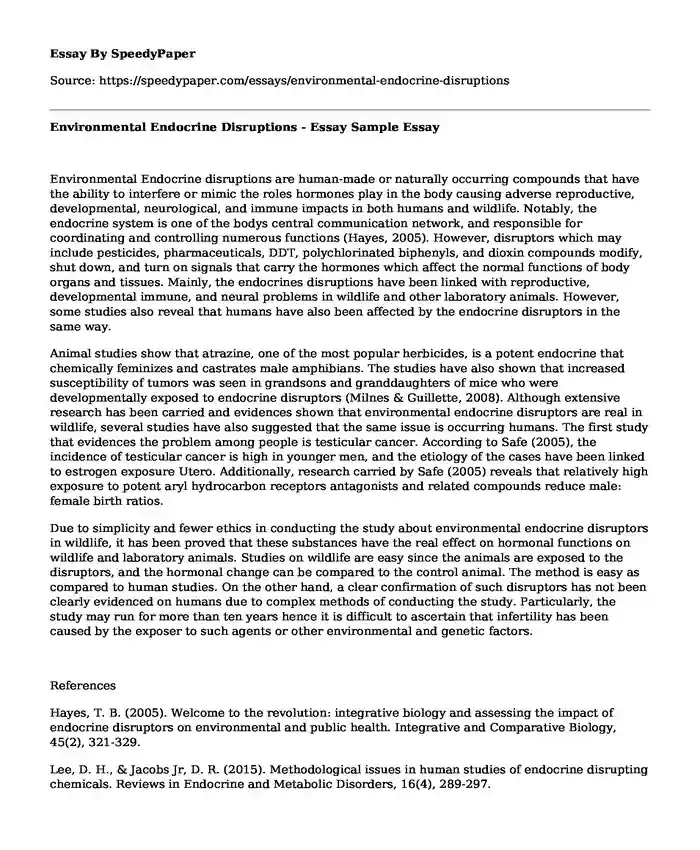Environmental Endocrine disruptions are human-made or naturally occurring compounds that have the ability to interfere or mimic the roles hormones play in the body causing adverse reproductive, developmental, neurological, and immune impacts in both humans and wildlife. Notably, the endocrine system is one of the bodys central communication network, and responsible for coordinating and controlling numerous functions (Hayes, 2005). However, disruptors which may include pesticides, pharmaceuticals, DDT, polychlorinated biphenyls, and dioxin compounds modify, shut down, and turn on signals that carry the hormones which affect the normal functions of body organs and tissues. Mainly, the endocrines disruptions have been linked with reproductive, developmental immune, and neural problems in wildlife and other laboratory animals. However, some studies also reveal that humans have also been affected by the endocrine disruptors in the same way.
Animal studies show that atrazine, one of the most popular herbicides, is a potent endocrine that chemically feminizes and castrates male amphibians. The studies have also shown that increased susceptibility of tumors was seen in grandsons and granddaughters of mice who were developmentally exposed to endocrine disruptors (Milnes & Guillette, 2008). Although extensive research has been carried and evidences shown that environmental endocrine disruptors are real in wildlife, several studies have also suggested that the same issue is occurring humans. The first study that evidences the problem among people is testicular cancer. According to Safe (2005), the incidence of testicular cancer is high in younger men, and the etiology of the cases have been linked to estrogen exposure Utero. Additionally, research carried by Safe (2005) reveals that relatively high exposure to potent aryl hydrocarbon receptors antagonists and related compounds reduce male: female birth ratios.
Due to simplicity and fewer ethics in conducting the study about environmental endocrine disruptors in wildlife, it has been proved that these substances have the real effect on hormonal functions on wildlife and laboratory animals. Studies on wildlife are easy since the animals are exposed to the disruptors, and the hormonal change can be compared to the control animal. The method is easy as compared to human studies. On the other hand, a clear confirmation of such disruptors has not been clearly evidenced on humans due to complex methods of conducting the study. Particularly, the study may run for more than ten years hence it is difficult to ascertain that infertility has been caused by the exposer to such agents or other environmental and genetic factors.
References
Hayes, T. B. (2005). Welcome to the revolution: integrative biology and assessing the impact of endocrine disruptors on environmental and public health. Integrative and Comparative Biology, 45(2), 321-329.
Lee, D. H., & Jacobs Jr, D. R. (2015). Methodological issues in human studies of endocrine disrupting chemicals. Reviews in Endocrine and Metabolic Disorders, 16(4), 289-297.
Milnes, M. R., & Guillette, L. J. (2008). Alligator tales: new lessons about environmental contaminants from a sentinel species. Bioscience, 58(11), 1027-1036.
Safe, S. (2005). Clinical correlates of environmental endocrine disruptors. Trends in Endocrinology & Metabolism, 16(4), 139-144.
Cite this page
Environmental Endocrine Disruptions - Essay Sample. (2020, Jan 26). Retrieved from https://speedypaper.com/essays/environmental-endocrine-disruptions
Request Removal
If you are the original author of this essay and no longer wish to have it published on the SpeedyPaper website, please click below to request its removal:
- The Underground Railroad Movie - Free Essay Sample
- The Modern Family, Free Essay on Gay Men's Stereotype
- Analyzing the Language of Advertising, Essay Example
- Free Essay Describing the Steps to Stimulate Economic Development in Developing Countries
- Essay Sample: Compassion in Undermining Political Suffering and Politically Achieved Rights
- Free Essay Comprising Literary Analysis on Shirley Jackson's "The Lottery"
- Paper Example on President Lincoln's War Aim
Popular categories





